Genre: Sports Developer: U.S. Gold Publisher: U.S. Gold Players: 1-8 Released: 1995
Head-On/Fever Pitch Soccer was very late to the game when it tried to push its way into the already highly saturated console soccer market. The Sensible Soccer and FIFA series were by this point in time established as popular and critically acclaimed brands on the Genesis. Not to mention that there were dozens of other games in this particular sports genre already out there. Nevertheless, British-based publisher U.S. Gold tried to make an impression with this game. Aside of a name-change for the U.S. market (where the game was called Head-On Soccer), what struck me most was that Fever Pitch Soccer got an exclusive celebrity endorsement specifically for the German market. Locally, the game is known as Mario Basler – Jetzt geht’s los (“now it begins”), though the original title is still there in small print (Mario Basler presents: Fever Pitch Soccer). For those of you not familiar with the German soccer landscape, in the year the game was released Mario Basler was an up-and-coming striker for SV Werder Bremen, having won the 1994 DFB Cup with his team and being the top scorer of the 1994/1995 season. What’s interesting is that this endorsement came way before his greatest successes in the league (he would go on to win the German championship twice after transferring to league rival FC Bayern Munich).
Now, Basler is somewhat of a controversial figure. For some, he was one of the greatest German soccer players of the 1990s, if not all time, highly talented and resourceful (three times, during the year he was top scorer, he shot a goal directly while executing a corner kick, which is indeed very impressive). For others he never reached his full potential, mostly due to personal flaws (he was known for mouthing off to the press, disagreeing with and verbally abusing his trainers and teammates, and in one infamous incident getting into a row at an ale house, which got him suspended from his team). This controversy actually lasts to this very day. His supporters point out that he is still called upon for commenting soccer games on live TV and giving his opinion on the current league situation for the press. His opponents counter by mentioning his lack of success as a trainer (his last team was relegated from third to fourth league last season) and the fact that most of his predictions for the season, which were printed in Germany’s biggest yellow press newspaper, turned out to be false, often to an almost hilarious degree.
So, why do I mention all of this? Because Head-On/Fever Pitch Soccer and its endorser actually have something important in common. For some, the game is one of the best representatives of its particular sports genre. For others, it has some inherent flaws that prevent it from achieving true greatness.
At a first, very superficial glance, Head-On/Fever Pitch Soccer may seem like a rip-off of FIFA International Soccer or FIFA ’95. The game uses virtually the same isometric perspective, there is a constant background noise emulating a stadium atmosphere, and voice samples for important occasions like goals. Once you see the game in motion, these apparent similarities divert a little. The gameplay is a tad faster, the graphics are very crisp, player sprites are smaller and have more animations (at least when compared to the first FIFA), and the voice samples are superb. U.S. Gold definitely did a great job there. Once you actually pick up a game pad and play for a bit, any similarity to EA’s series goes right out of the window: Head-On/Fever Pitch Soccer eschews the simulation aspect of a soccer game almost completely (aside from the occasional penalty – more on that later), and banks fully on a fast, action-oriented gameplay experience.
The arcade-like presentation starts with the main menu, as there are only very few options. There gameplay modes are exhibition (single match) or tournament, where you pick one out of 51 national teams. Interestingly enough, you don’t play an emulated World Cup or any existing tournament. The matches are separated into four cups, each roughly representing four continents (Asia, Africa, Europe and the Americas). After winning seven matches in a row for one specific region, you advance to the next one. Gameplay is saved in a way by means of a password system, which can be accessed from the main menu with the “resume” option. Finally, you can adjust the playtime (from one minute to 15 minutes per half), strictness of the referee (interestingly called “Aggro on/off”) and the difficulty (easy, normal or hard) – that’s pretty much it. Compared to other games in the genre, this seems very sparse.
Interesting to note is that each team consists of 11 players – and only 11 players! There are no injuries and no substitutions either. Players don’t even have separate ratings. Rather, a nation’s strength is determined from how many star players a team has. These come in different varieties, and some of them have a certain “special attack.” Star strikers, for example, shoot elegantly curved balls or powerful flaming shots. One particular special player worth mentioning is “the Cheat.” Upon pressing the button for the special attack, this particular player takes a dive and fakes a foul, upon which you can be awarded a penalty shot, even if he was nowhere near the ball or even any opponent! Each player type has his own character sprite, so knowing what a particular star looks like helps immensely. Also worth mentioning is that when you start a tournament, you begin with no star players, regardless of the team you picked; you have to earn them first! If you win particularly high you get awarded with a star. If you win only barely, it takes longer for a special player to appear. Since you don’t have any stars at the beginning of a tournament, picking a nation does little except for determining what formation you play in (which, by the way, can’t be adjusted either. You always play in a particular formation determined by the team you pick).
As already mentioned, Head-On/Fever Pitch Soccer has more of an arcade-style feel to it. The gameplay is fast, there aren’t any substitutions or changes in formation possible, and there’s no offside-rulings. It may feel a bit like FIFA soccer at first, but Head-On/Fever Pitch is faster, and the ball physics are looser. The leather doesn’t stick to the player at once, but may bounce away from him at first; you need to run a little with the ball to get it under control. Different pitch surfaces change the ball behavior, more noticeable here than in any other game. On sandy surface the ball is slower, on rocky pitches it bounces higher, etc.
There are penalties, but they are rather rare, so most of the time it feels like you could freely tackle away or literally kick the opponent to the ground. Occasionally though, a foul gets penalized, especially when it was made in the penalty zone. In fact, it appears more likely that a penalty is awarded after The Cheat took a dive than when a “normal” foul occurred. Other than one might expect at first, there even are yellow and red cards handed out. Though you never get red cards straight away, only after repeat offenses. Also, a player only gets suspended for the current game, not for several matches. Fever Pitch Soccer definitely grants more leeway when it comes to freely tackling your opponent than most other soccer games do. It definitely rewards dirty play though, and when you play against the computer it may be a bit frustrating to see how deliberately the AI is kicking your players to the ground.
One big problem the game has lies in its controller layout. If you play with a six-button-pad, you shoot with the X-button and pass with A, while B executes the special attack for star players. This pattern changes when using a three-button controller: There, A is still for passing, but now B shoots and the special maneuver is triggered with the C-button. There are also tricks like back heel- or cross passes. Personally I recommend playing the game with three buttons only, even if you have to execute the Back heel by pressing A+B together. The three-button layout feels more natural, and being forced to use all six fire keys on a corresponding controller needlessly complicates things, especially when its about a fast paced, action-oriented game.
Another thing worth mentioning is how the game handles multi-player. Head-On/Fever Pitch Soccer actually allows up to eight players simultaneously, provided you use two multi-player adapters. However, only one player can control the active player per team at a time. Whenever a successful pass has been completed, the second player takes over. Should the ball be intercepted, the player stays in charge until he regains the ball and manages to pass it along. This system has its advantages, as the team isn’t torn far apart when the opponent launches a counter. However, if a player can’t get the ball under control, he will stay in charge until his team will have another kickoff. The mechanic may lead to some nasty falling out between friends though, as the player against whom a goal was scored will get all the blame from his teammates. Also, the time each player is in charge can vary wildly – one may be able to dribble forever or constantly needs to run back and forth between offense and defense, while another may immediately pass the ball on to the next teammate and then has to wait until everyone else has had his turn before getting another go.
Overall though, Head-On/Fever Pitch Soccer is a pretty good sports game. If you like fast a fast pace and prefer action over simulation, you should give this one a try. The presentation is a bit too minimalist, and the control scheme may appear a bit unintuitive at first. But once you get the hang of it the game will provide some good fun and entertainment. Head-On/Fever Pitch Soccer is definitely one of the better soccer titles available for the Sega Genesis.
SCORE: 7 out of 10

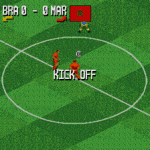
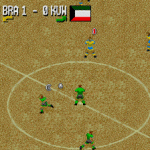
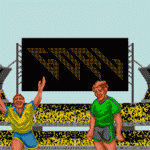
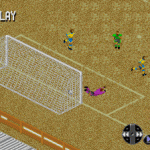
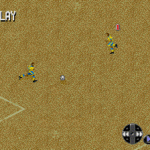
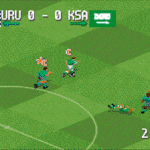
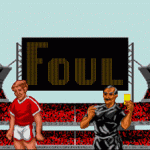
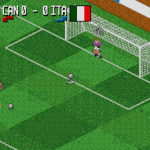
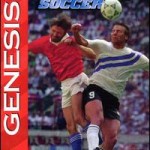
Recent Comments